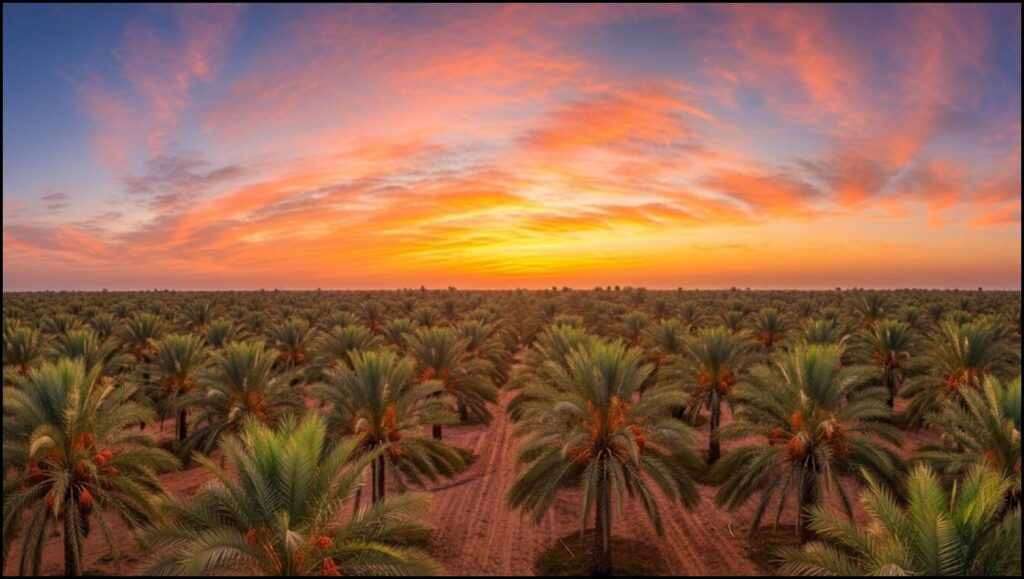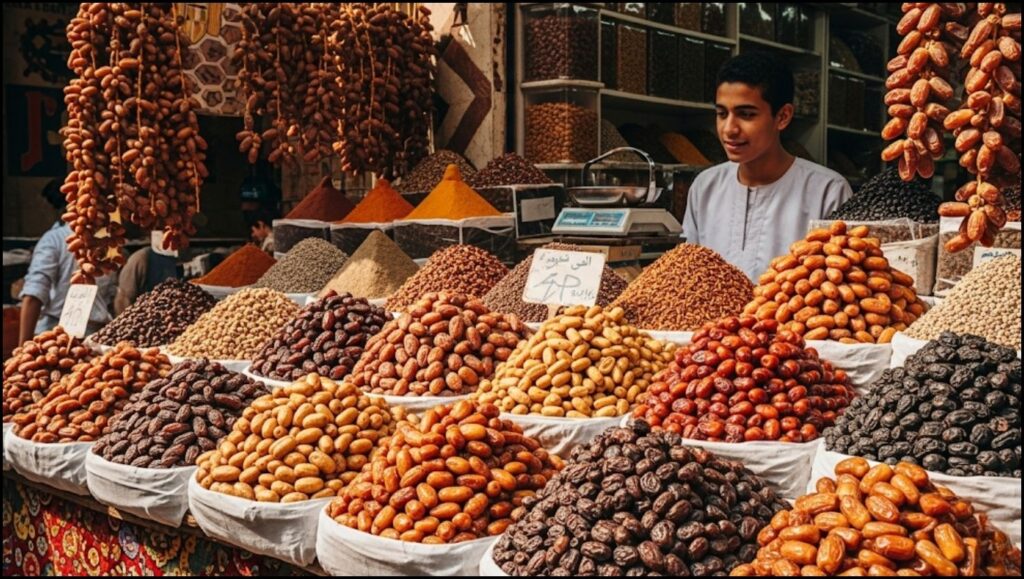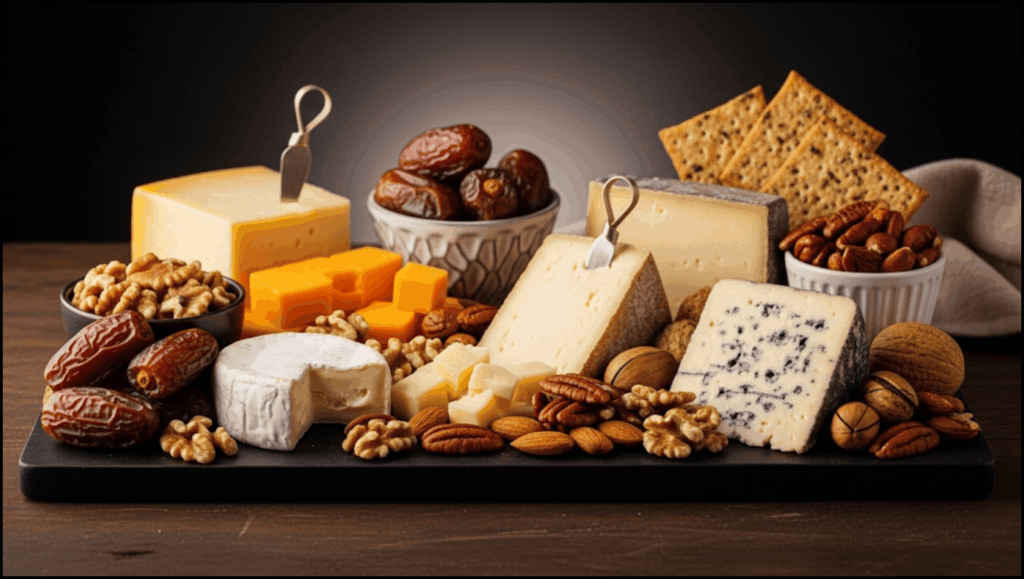
There is something truly magical about a perfect date. Its glossy, wrinkled skin gives way to a tender, caramel-like flesh that seems to capture the very essence of the sun. This humble fruit, a staple of pantries and a jewel of charcuterie boards has nourished civilizations for millennia. But have you ever paused, while enjoying its rich sweetness, to wonder where it comes from? The answer may surprise you.
This journey will take us to the sun-drenched landscapes that cradle this ancient crop. We’ll uncover which country is the largest date producer, explore the most coveted varieties that grace our tables, and even learn how you, the home gardener, can cultivate a piece of this legacy. Let’s delve into the world of the magnificent date palm.
Quick Tips for the Date Enthusiast
Here are the key things to know about the world of dates.
- Top Producer: Egypt is the undisputed leader in date production by volume, growing nearly 1.7 million metric tons annually.
- Top Exporter: While Egypt grows the most, Saudi Arabia is currently the world’s leading exporter of dates by value.
- Most Famous Variety: Medjool dates, known for their large size and soft, chewy texture, are often called the “King of Dates.”
- Home Growing: Growing date palms is possible in very specific climates—think of the hot, arid conditions of USDA zones 9-11.
The Surprising Answer: Unveiling the World’s Largest Date Producer
When we think of world-class delicacies, we might imagine French wine or Italian cheese. But for dates, the heart of production lies in North Africa and the Middle East. For years, the title of the world’s largest date producer has been firmly held by Egypt. According to the most recent data from the United Nations’ Food and Agriculture Organization (FAO), Egypt produces a staggering volume of dates, far surpassing other major growers.
However, there’s a fascinating distinction between production and exportation. Egypt consumes most of its enormous harvest domestically, where dates are a deeply ingrained part of the culture and cuisine. Other countries, like Saudi Arabia, Tunisia, and Iran, are also titans in the date world and play a more significant role in the international market you see in your local grocery store. In my own travels, I’ve found it remarkable that the dates we most commonly buy often come from these major exporters, while the biggest producer saves its bounty for its own people.
This global dance of date palm cultivation means that the variety you enjoy might come from a sun-baked grove in Tunisia, a historic oasis in Saudi Arabia, or a family farm along the Nile.

A Legacy Written in Leaves: The Art of Date Palm Cultivation
The date palm, Phoenix dactylifera, is not just a plant; it’s a symbol of life in the desert, a provider of food and shelter for over 6,000 years. Its cultivation is an art form passed down through generations. Understanding how they are grown gives you a much deeper appreciation for the fruit.
Date palms are dioecious, meaning there are separate male and female trees. The male palms produce flowers with pollen, but no fruit. The female palms produce flowers that, if pollinated, will blossom into clusters of dates. In commercial groves, pollination is a meticulous, manual process. Workers climb ladders to collect pollen from the male flowers and then carefully dust it onto the female flowers to ensure a successful crop. A common mistake I see new gardeners make is underestimating this step; without pollination, a female palm will not bear fruit.
These majestic palms thrive in conditions that would be punishing for most other fruit trees. They require long, intensely hot, and dry summers to properly develop the sugars in their fruit. While they are famously drought-tolerant, a critical horticultural secret is that they need consistent access to groundwater or irrigation to produce the plump, succulent dates we love. They have a famous saying in the Middle East: “a date palm must have its feet in water and its head in the fire of the sky.”
A Connoisseur’s Guide to Dates: From Medjool to Deglet Noor
Just as there are countless varieties of apples, there is a dazzling world of dates, each with a unique profile of flavor, texture, and color. Exploring these varieties is a true delight for the palate.
The Regal Medjool Date
Often hailed as the “King of Dates,” the Medjool date is prized for its impressive size, soft and fibrous texture, and rich, caramel-like sweetness. Originally reserved for Moroccan royalty, Medjools are now grown in hot, dry regions of the United States, Mexico, and the Middle East. They are so tender and moist they are best enjoyed fresh, as a standalone treat. For a simple, elegant dessert, my go-to is to fill a pitted Medjool with creamy goat cheese and a sprinkle of crushed pistachios—it’s simply divine.
The Elegant Deglet Noor
If the Medjool is the king, the Deglet Noor is the queen. Translating to “date of light,” this variety is famous for its beautiful translucent amber color when held up to the sun. It’s a semi-dry date, with a firmer texture and a delicate, slightly nutty flavor that is less intensely sweet than a Medjool. This quality makes it incredibly versatile. I find it’s the perfect date for baking, as it holds its shape wonderfully in scones, breads, and cakes.

Other Gems to Discover
Keep an eye out for other fantastic varieties:
- Barhi: Sold on the vine in their yellow, crunchy stage (khalal), they taste like a crisp apple or coconut. As they ripen, they become soft and syrupy.
- Halawy: Its name means “sweet” in Arabic, and it lives up to it with a buttery, honeyed flavor and soft flesh.
- Zahidi: A firm, chewy, and less sweet date with a nutty flavor, often called the “butter date.” It’s excellent for cooking.
Can You Grow Your Own? A Guide to Growing Date Palms at Home
For the truly ambitious gardener living in the right climate, growing date palms can be an incredibly rewarding long-term project. It requires patience and specific conditions, but the reward is a stunning landscape tree and, eventually, your very own harvest.
Climate is Everything
First, you must have the right environment. Date palms require blistering summer heat and low humidity to produce good fruit. They are best suited for USDA Hardiness Zones 9 to 11, thriving in the desert climates of Southern California, Arizona, and parts of Nevada and Texas. Unfortunately, they will not fruit in humid, subtropical climates like Florida, as the moisture can cause the fruit to spoil on the tree.
Getting Started: Suckers, Not Seeds
I’ve seen many gardeners try to grow a palm from a grocery store date pit. While a fun experiment, it’s a gamble. A seed-grown palm has a 50% chance of being a non-fruiting male, and even if it’s female, the fruit won’t be “true to type,” meaning it won’t have the same qualities as the parent date.
The proper way to propagate a specific variety is by planting a sucker, or an offshoot, from the base of a mature female palm. This creates a genetic clone of the mother tree, guaranteeing both its sex and fruit quality.
Planting and Long-Term Care
- Soil: Date palms need excellent drainage. A sandy or sandy loam soil is ideal.
- Water: Water newly planted palms regularly to establish their roots. Mature palms are drought-tolerant but produce the best fruit with deep, infrequent irrigation during the spring and summer.
- Patience: It can take 4 to 8 years for a sucker-planted palm to produce its first significant harvest, so this is truly a labor of love.
A Sweet Conclusion
From the vast, sun-scorched groves of Egypt to the single, majestic palm in a desert garden, the date represents a story of resilience, patience, and sweet reward. Knowing that this simple fruit is the product of such intense heat, careful cultivation, and millennia of history adds a layer of richness to its flavor.
Whether you are simply enjoying a handful of Medjool dates as a healthy snack, artfully arranging them on a platter for guests, or embarking on the grand adventure of growing your own, you are participating in an ancient and delicious tradition. The next time you taste that familiar caramel sweetness, perhaps you’ll think of the fiery sky and life-giving water that brought it to be.
The Global Guava Trade: How Mexico Became the World’s Largest Guava Exporter
